[social_warfare]
Feared the world over, the black mamba is one of the most venomous reptiles on earth and one of the most aggressive snake species.
Also referred to as the black-mouthed mamba, or Swart mamba in Afrikaans, this ferocious reptile is second only to the King Cobra when ranking the largest venomous snakes in the world.
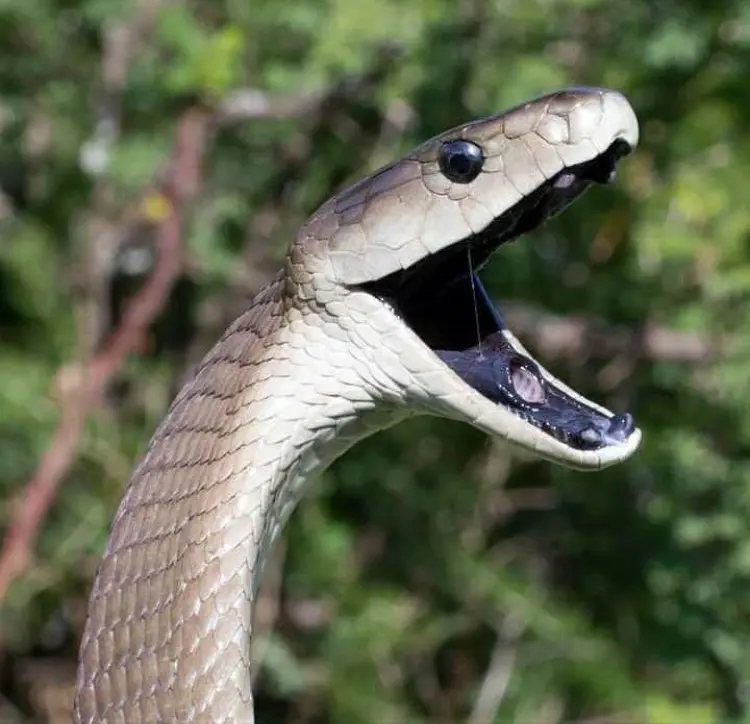
What Is The Black Mamba?
The black mamba is the largest venomous snake in Africa and the fastest moving snake on earth.
The species is common across sub-Saharan Africa where it thrives in savanna woodland savanna areas and preys on large rodents, killing them with their highly toxic venom.
Appearance
What does the black mamba look like?
The easiest way to identify a black mamba is by its coffin-shaped head, pronounced brow ridge and large eyes. This is a trait only shared by other mamba species – the green mamba and the Jameson’s mamba – which can be easily distinguished by colour.
Despite their name, they are actually not black. Instead they vary in colour from greyish brown to olive with a light underbelly. Juveniles are lighter in colour than adults, and their pupils are surrounded by a silvery-white or yellow colour.
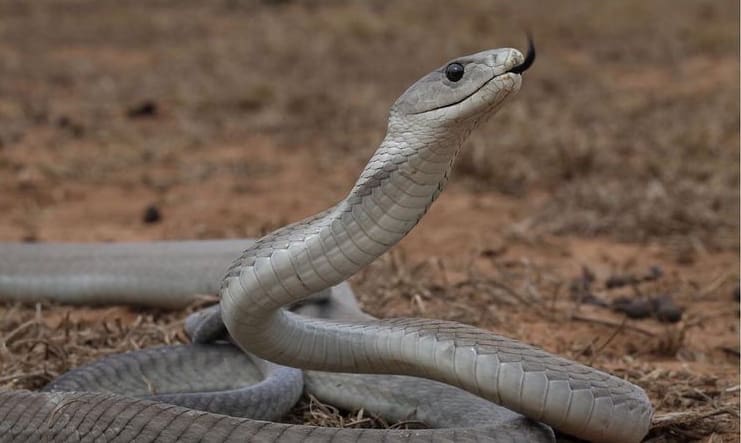
How big is the black mamba?
The black mamba is the largest venomous snake in Africa. Females are the bigger gender, as is the case with all snake species. The average adult grows to around 8 foot (2.5 metres), but larger individuals can comfortably exceed 14 foot (4 meters) in length. They are a slender built serpent and will range between two and twelve pounds (1-5 kilograms) in weight.
If they’re not black, why are they called the black mamba?
The name ‘black mamba’ comes from the jet-black inside of the their mouths. This is readily shown off during threat displays, and is unique to the species. Green and Jackson’s mambas have white mouths, as do all other snake species.
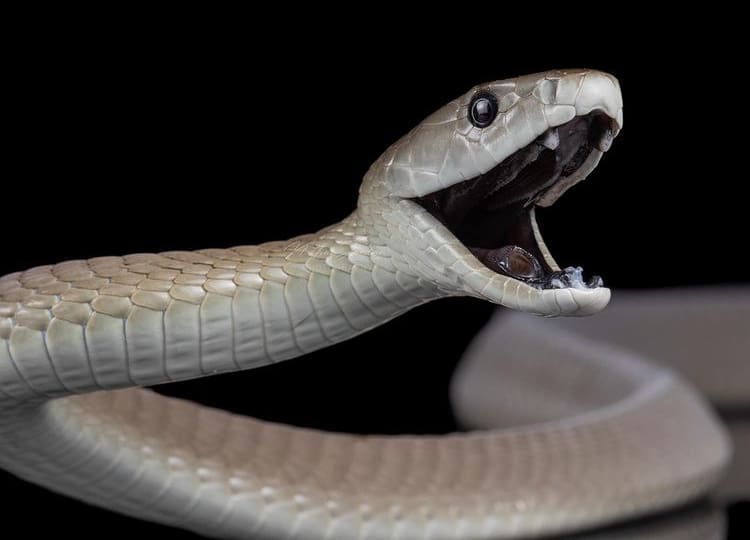
Behaviour
What does the black mamba eat?
Black mambas are carnivores and feed on a variety of animals. Their preferred prey items vary dependant on age and size. Hatchlings will feed on young rodents, birds and lizards while adults usually prey on rock hyrax (dassie’s), rabbits, birds, large rodents and other similarly sized mammals.
The black mamba is an ambush hunter rather than a chaser. They will usually hunt from a permanent ‘lair’ and wait patiently for a prey item to cross their path. When the opportunity arises they will unleash a violent strike, biting into their victim multiple times before releasing. At this point they let their venom do the rest of the work before proceeding to swallow their victim whole.
Depending on the size of the prey item, black mambas can feed as little as once every few weeks.
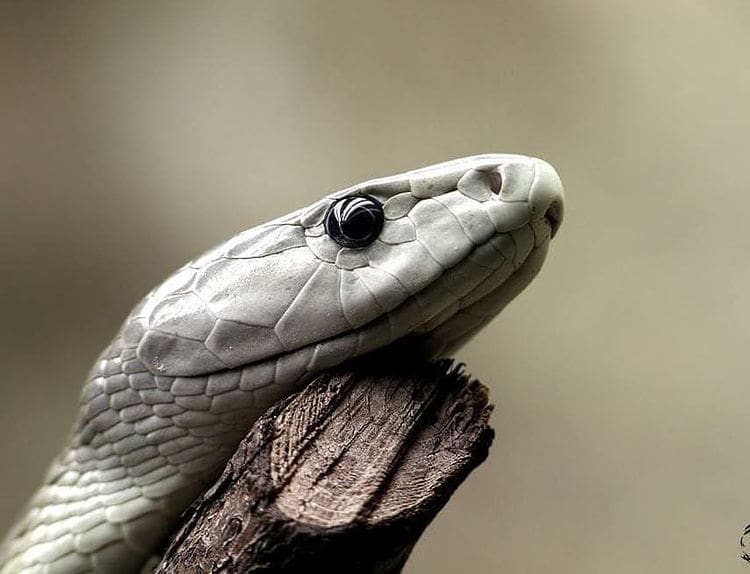
Is the black mamba venomous?
Not only are they large and aggressive, but the black mamba is also one of the most venomous snakes in the world, and the most venomous reptile in Africa.
They possess a potent neurotoxic venom, so lethal that even a single-drop is capable of killing an adult elephant. In humans, symptoms begin showing after just a few minutes. These include; drooping eyelids, blurred vision, shortness of breath, slurred speech, difficulty swallowing, collapse or unconsciousness and ultimately, respiratory failure.
They will typically bite multiple times before letting go and if left untreated, a black mamba bite will result in death within 24 hours.
Is the black mamba fast?
In addition to their highly toxic venom, the black mamba is the fastest snake on earth. They are able to exceed speeds of 12.5 miles per hour (20 kilometres per hour) at full sprint.
Although they are known to actively chase down a threat, they will usually only reach such high speeds when fleeing from danger.
When threatened they will swiftly dart into the nearest burrow or crevice and despite their reputation, they will always look to flee before showing aggression. However, if they feel cornered they will engage in a threat display that includes mock striking, hissing and gaping to expose their black mouth.
Black mamba reproduction
Black mambas are solitary animals that don’t particularly tolerate the presence of other snakes, including those of their own species. Although they prefer warm-blooded prey, they have also been known to cannibalize other snakes.
Mating season begins in the spring, and the black mamba will start to roam the bush looking for a mate. Both males and females will mate with multiple partners during this time, and males routinely engage in territorial fights for mating rights. These ‘wrestling matches’ see males trying to subdue each other by intertwining their bodies and battling with their necks.
Mating is instigated by a female lifting its tail and staying still enough for the male to mount.
Around two months after copulation the female will seek out an appropriate nest site and lay a clutch of between 5 and 20 eggs on average. Incubation lasts about 2 to 3 months and hatchlings will live independently from birth.

Habitat & Range
Where do black mambas live?
Black mambas are both terrestrial and arboreal, and they will frequently move between the trees and the ground. On the ground they will use termite mounds, rock crevices and abandoned mounds as shelter, while in the trees they will use holes or birds nests.
As a cold-blooded species, the black mamba cannot regulate its body temperature. Instead they will often spend cooler days warming themselves in a sunny spot. However, in warmer temperatures they will seek respite in a cool burrow to prevent overheating. They are also known to frequent the same basking sites and burrows. They are diurnal and spend the night time in their ‘den’.
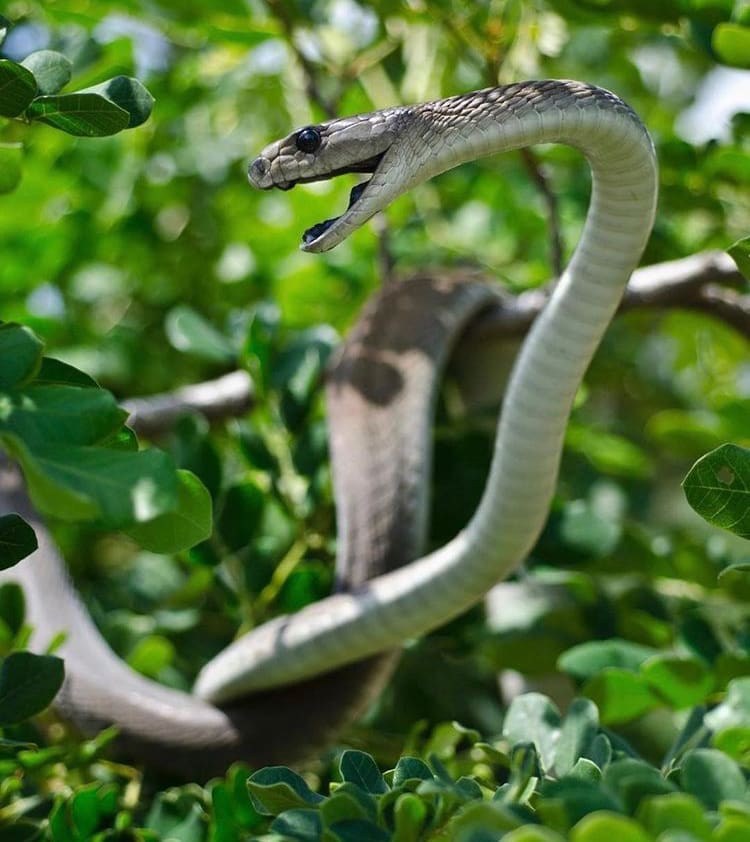
The species is quite widespread across sub-Saharan Africa and prefers relatively dry environments. These include; woodlands, scrub, rocky outcrops and savanna grasslands. However, they can also be found in moist savanna and lowland forests.
The black mamba can be found in the following countries: Angola, Botswana, Burkina Faso, Cameroon, Central African Republic, Democratic Republic of Congo, Eswatini, South Sudan, Ethiopia, Eritrea, Somalia, Kenya, Uganda, Tanzania, Burundi, Rwanda, Mozambique, Malawi, Zambia, Zimbabwe, South Africa and Namibia.
Conservation
How many black mambas are there in the wild?
Due to the size and lifestyle of the species, it is not possible to track population numbers and therefore the exact number of wild black mambas is not known.
Is the black mamba endangered?
The black mamba is currently listed as ‘Least Concern’ on the IUCN red list, and is not an endangered species.
Threats to the black mamba
At present, there are no major threats to the black mamba species. Deforestation and human encroachment could be seen as a potential threat, but at this stage there is no evidence to suggest that this is having any impact on wild populations due to the large range they inhabit.

Safari
The best places to see the black mamba
Black mambas are very common, and widespread throughout sub-Saharan Africa. Particularly in warm, tropical regions.
As an elusive species, reptile species, the black mamba is not easy to find in the wild. Even for experienced guides and herpetologists, seeking out these snakes is a very hands on task and can take hours or even days.
For this reason, any sighting of a black mamba in the wild can generally be put down to extreme luck of the draw and should be considered quite a privilege. That being said, their range does cover a large portion of commercial national parks and game reserves and many lucky safari-goers are fortunate enough to spot them from the safety of a vehicle.
Here are some of the best places to see black mambas in Africa:
- Kruger National Park, South Africa
- Masai Mara National Reserve, Kenya
- Serengeti National Park, Kenya
- iSimangaliso Wetland Park, South Africa

Tips for spotting the black mamba in the wild
Without professional tracking and a huge amount of patience, you’re unlikely to see a black mamba in the wild unless you see one out in the open or on a nearby tree.
- Drive slowly – If you’re self-driving through a national park or game reserve and looking for snakes, you’re best bet is to drive very slowly and keep a keen eye on the road and vegetation along the side of the road. Black mambas are very well camoflauged and you will not spot them without a keen eye and a steady space.
- Night cruise – Snakes will often venture out onto the road in the evening as the tar holds heat better than natural substances like rocks or sand. Reptile enthusiasts will often drive along roads in wilderness areas during the night in hopes of spotting a snake on the road.
- Scan the trees – Black mambas spend a large amount of time in the trees, and this is where they’re easiest to spot while inside a vehicle.
- Go on a guided safari – Luxury lodges and safari companies offer guided game drives where a skilled ranger will guide you through the bush and help you to spot wildlife. They are trained in tracking animals in the wild and will help guide you through the best things to look for in search of a black mamba.
- Be respectful – Black mambas are one of the most dangerous animals on earth and should be treated with the utmost respect and caution. Please do not ever approach a black mamba, whether on foot or in a vehicle. Maintain a safe distance at times and don’t underestimate the snake’s unpredictability.
Facts about the black mamba
- They can launch 40% of their body length – Black mambas are vicious strikers and can propel their body forward up to 40% of its overall length in one violent strike! This can be more than 7ft. (2 metres) in larger individuals.
- They are known as the most dangerous snake in the world – Given the combination of size, speed, aggression and venom toxicity, the black mamba is widely considered as the most dangerous snake in the world.
- They are the 15th most venomous snake in the world – Most people think the black mamba’s venom is a lot more toxic than it actually is. It finds itself outside of the top 10 most venomous snakes on earth, however due to the high amount of venom in injects – its still right at the top of the most deadly list.
- Their venom can kill a human in 20 minutes – A black mamba’s venom will start causing side-effects in a human within a couple minutes and can bring about full cardiac arrest within 20 minutes.
Myths about the black mamba
- The black mamba is not black – The black mamba’s skin is actually not black. Instead their name comes from the dark blue-black colour of the inside of their mouths.
- Black mambas do not actively chase or ‘hunt’ humans – Although they are aggressive and are known to physically chase off threats, they do not actively stalk, hunt or chase humans in order to kill them.
- They do not coil into a ball to roll down hills – One of the more abstract myths about black mambas is that they will bite onto their tails, coil into a ball and roll down a hill before shooting back into position and chasing down their prey. This is entirely false, and not a behaviour associated with black mambas.
- They cannot balance on the tips of their tails – Black mambas are known to stand up quite high during threat displays, almost identical to what a cobra would do. Due to the size of adults, they can stand up tall enough to stare a grown man straight in the eye. This led to the belief that they can stand up on the tips of their tails, however this is not true. Generally they wouldn’t be able to lift more than 50% of their body off the ground at once.
